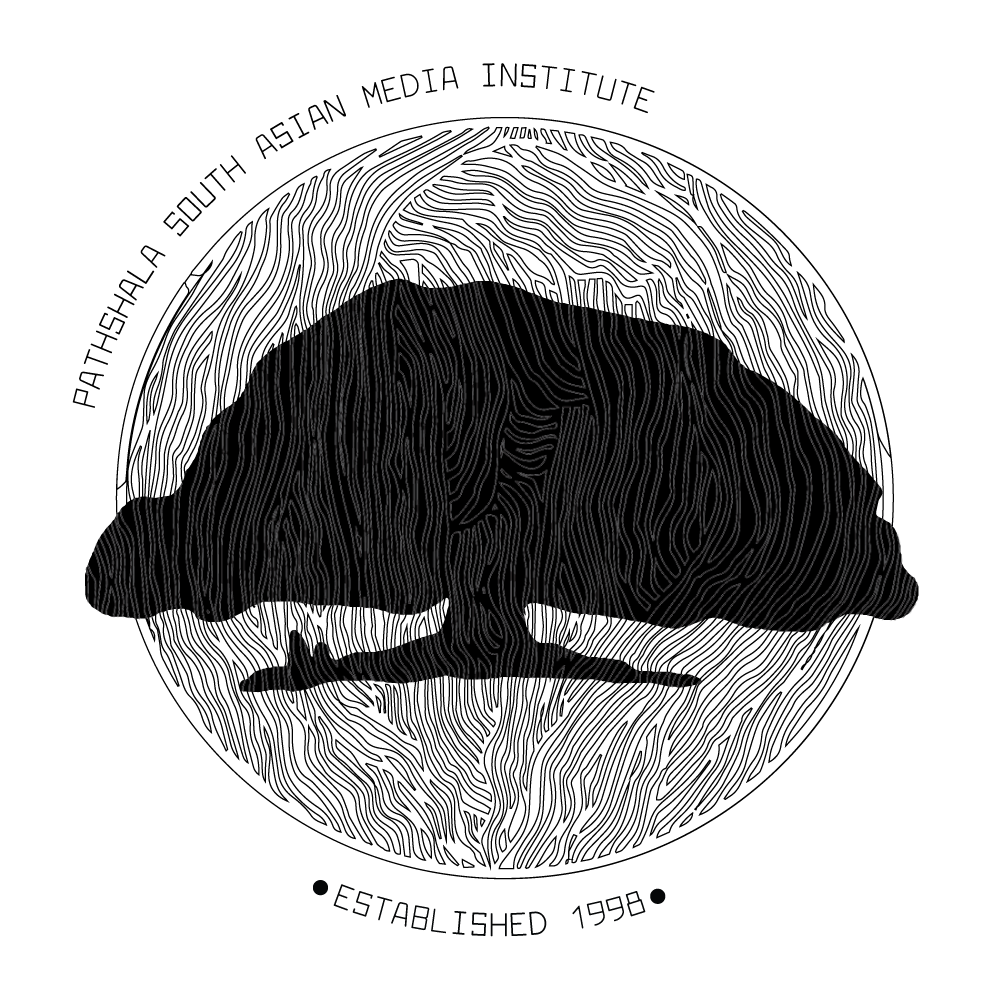Shahidul Alam: From the Ripples of Brahmaputra Dairy
/ Momena Jalil
Shahidul Alam is a man known to stand for what he believes in. He is an activist, an advocate of truth, a believer and a dreamer of a better world. And to me, he is also an outstanding photographer. I have two favorite photographers and I am very lucky that both were my teachers. One of them is Shahidul, whose work I find quite like Van Gogh’s paintings. There is reality that is hidden under the surface, but you have to look with your soul to see them.
In the Bangladeshi photography arena, the pioneers are charismatic: like Golam Kasem Daddy, Manzoor Alam Beg and many more. Sadly, I have never met them. The first photographer who inspired me, years before I started photography, is Shahidul.
When I started my study at Pathshala in 2001, I had just lost my father, and life was extremely difficult. It was Pathshala that saved me from drowning in grief. Most of our teachers were exceptionally good but I especially enjoyed Shahidul’s classes; and harboured a healthy fear of him too. At that time, he was working on Brahmaputra Diary. I fell deeply in love with this series, and it still remains one of my favorites.
The majority of Shahidul’s works are heavily laced with political undertones, highlighting his strong alignment with human rights activism. May it be Kalpana's Warriors, Crossfire or documentaries on marginalized communities. But Brahmaputra Diary is different: it shows a side of him which unleashes a photographer who is willing to diverge from his modus operandi. Shahidul’s works usually revolve around people, from his intense documentation on migrant workers and the survivors of climate devastation, to the victims of the crossfire; it is always about the people, the injustice and the suffering that they endure, the breach of their rights.
What I find fascinating is that Brahmaputra Diary is a completely different genre. Here he portrays a river that changes its flow, depth, climate, nature, name and landscape running as long as 1800 miles crossing three countries: from the Chemayungdung glacier at Tibet, China, flowing over the outline of Nepal and Bhutan, then taking a sharp entry into India through Arunachal Pradesh and flowing through Assam and Bangladesh before joining the Bay of Bengal. No, many would not take on this project; it is costly and requires a long time to accomplish. And at some point, it is dangerous too, as it requires following a river that runs through no man’s land and enemy terrain. Did Shahidul encounter obstacles? He surely did, but that did not put him off.
In 2001, when Shahidul was taking our class at Pathshala, this was still an active project. He talked about it in class, and I was spellbound by the colossal nature of this tale, the breathtaking images. Now when I look back I wonder how difficult it must have been for a photographer to compile this body of work. When a photo story is created, we maintain a certain harmony: a characteristic pattern that links one image to the other. But the tricky part with Brahmaputra Diary is that it has changing landscapes; the whole atmosphere of the photographs changes from one region to another, from the snow covered range of the Himalayas to the salt water of Nijhum Dwip - this is an epic photo documentation.
The history of this river is also very interesting. Brahmaputra River is an antecedent river; it existed before the Himalayas began to rise and carved its path through the rising landmass as the Himalayas uplifted. Around 40-50 million years ago, the Indian plate collided with the Asian plate. The intense pressure from the collision caused the landmass to fold, fault, and rise upwards, creating the Himalayan Mountain range. Instead of changing its course, the Brahmaputra continued to flow, cutting down through the crust as the Himalayas arose, creating its unique path through the mountains. An earthquake in 1787 caused the Brahmaputra River to change its course, forming what is now known as the Jamuna River.
Brahmaputra Diary, first developed as a book, was supported by HDFC Asset Management Company Limited, and Shahidul’s journey itself was funded by a Bangladeshi industrial conglomerate called BEXIMCO. Shahidul convinced them to bring out a series of calendars from 1999 to 2001. Alongside this, the images have been published in a range of ways, from the National Geographic, to a small gallery in Aleppo, Syria, which brings out postcards. In our classes he taught us how to develop a photo project, and arrange funds for it and plan it in a way to build a structure that supports it to become successful. Brahmaputra Diary is clearly an excellent example.
The series has some 74 images from the countries China, India and Bangladesh. I have some personal favorites which helped me develop as a photographer. Let's go through some of them. No one gives a better intro of Brahmaputra Diary than Shahidul himself.
“Like a Hindu deity, the river has many incarnations, changing its name and nature as it flows along its 2900 km journey from its source near the holy mountains of Kailash through the icy glaciers in Tibet, the green mountains in India, and through the fertile plains of Bangladesh into the Bay of Bengal. Near the source, the river is called Tamchok Khambab Kangri, meaning ‘the river coming out of the horse’s mouth’. According to legend, Tamchok Khamabab spilled from a glacier in the Chemayudung Mountains. The Tibetans know it as the Yarlung Tsangpo, the purifier. In India, it is known as the Brahmaputra. In Bangladesh, it is also known as the Jamuna, the Padma and finally, the Meghna, before it opens into the sea.” Shahidual Alam writes, in the book, Brahmaputra Diary: A Journey To The Source of Asia’s Greatest River, (publisher: Pratham Books.)
In the Bangladeshi photography arena, the pioneers are charismatic: like Golam Kasem Daddy, Manzoor Alam Beg and many more. Sadly, I have never met them. The first photographer who inspired me, years before I started photography, is Shahidul.
When I started my study at Pathshala in 2001, I had just lost my father, and life was extremely difficult. It was Pathshala that saved me from drowning in grief. Most of our teachers were exceptionally good but I especially enjoyed Shahidul’s classes; and harboured a healthy fear of him too. At that time, he was working on Brahmaputra Diary. I fell deeply in love with this series, and it still remains one of my favorites.
The majority of Shahidul’s works are heavily laced with political undertones, highlighting his strong alignment with human rights activism. May it be Kalpana's Warriors, Crossfire or documentaries on marginalized communities. But Brahmaputra Diary is different: it shows a side of him which unleashes a photographer who is willing to diverge from his modus operandi. Shahidul’s works usually revolve around people, from his intense documentation on migrant workers and the survivors of climate devastation, to the victims of the crossfire; it is always about the people, the injustice and the suffering that they endure, the breach of their rights.
What I find fascinating is that Brahmaputra Diary is a completely different genre. Here he portrays a river that changes its flow, depth, climate, nature, name and landscape running as long as 1800 miles crossing three countries: from the Chemayungdung glacier at Tibet, China, flowing over the outline of Nepal and Bhutan, then taking a sharp entry into India through Arunachal Pradesh and flowing through Assam and Bangladesh before joining the Bay of Bengal. No, many would not take on this project; it is costly and requires a long time to accomplish. And at some point, it is dangerous too, as it requires following a river that runs through no man’s land and enemy terrain. Did Shahidul encounter obstacles? He surely did, but that did not put him off.
In 2001, when Shahidul was taking our class at Pathshala, this was still an active project. He talked about it in class, and I was spellbound by the colossal nature of this tale, the breathtaking images. Now when I look back I wonder how difficult it must have been for a photographer to compile this body of work. When a photo story is created, we maintain a certain harmony: a characteristic pattern that links one image to the other. But the tricky part with Brahmaputra Diary is that it has changing landscapes; the whole atmosphere of the photographs changes from one region to another, from the snow covered range of the Himalayas to the salt water of Nijhum Dwip - this is an epic photo documentation.
The history of this river is also very interesting. Brahmaputra River is an antecedent river; it existed before the Himalayas began to rise and carved its path through the rising landmass as the Himalayas uplifted. Around 40-50 million years ago, the Indian plate collided with the Asian plate. The intense pressure from the collision caused the landmass to fold, fault, and rise upwards, creating the Himalayan Mountain range. Instead of changing its course, the Brahmaputra continued to flow, cutting down through the crust as the Himalayas arose, creating its unique path through the mountains. An earthquake in 1787 caused the Brahmaputra River to change its course, forming what is now known as the Jamuna River.
Brahmaputra Diary, first developed as a book, was supported by HDFC Asset Management Company Limited, and Shahidul’s journey itself was funded by a Bangladeshi industrial conglomerate called BEXIMCO. Shahidul convinced them to bring out a series of calendars from 1999 to 2001. Alongside this, the images have been published in a range of ways, from the National Geographic, to a small gallery in Aleppo, Syria, which brings out postcards. In our classes he taught us how to develop a photo project, and arrange funds for it and plan it in a way to build a structure that supports it to become successful. Brahmaputra Diary is clearly an excellent example.
The series has some 74 images from the countries China, India and Bangladesh. I have some personal favorites which helped me develop as a photographer. Let's go through some of them. No one gives a better intro of Brahmaputra Diary than Shahidul himself.
“Like a Hindu deity, the river has many incarnations, changing its name and nature as it flows along its 2900 km journey from its source near the holy mountains of Kailash through the icy glaciers in Tibet, the green mountains in India, and through the fertile plains of Bangladesh into the Bay of Bengal. Near the source, the river is called Tamchok Khambab Kangri, meaning ‘the river coming out of the horse’s mouth’. According to legend, Tamchok Khamabab spilled from a glacier in the Chemayudung Mountains. The Tibetans know it as the Yarlung Tsangpo, the purifier. In India, it is known as the Brahmaputra. In Bangladesh, it is also known as the Jamuna, the Padma and finally, the Meghna, before it opens into the sea.” Shahidual Alam writes, in the book, Brahmaputra Diary: A Journey To The Source of Asia’s Greatest River, (publisher: Pratham Books.)
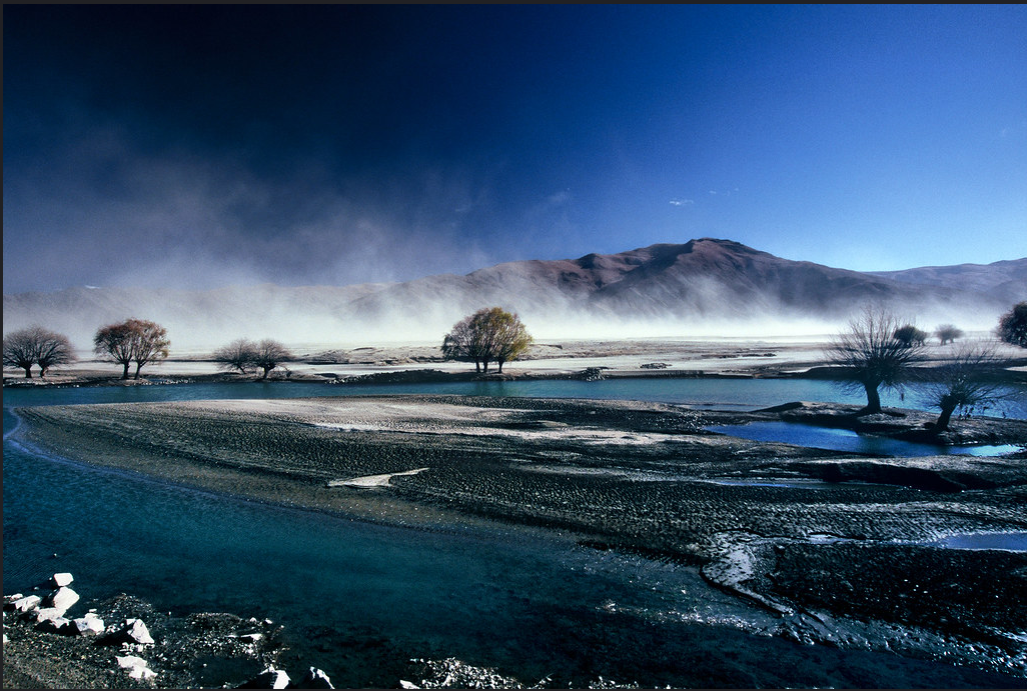
Sandstorm 1999. on the outskirts of Lhasa in Tibet (China) © Shahidul Alam / Drik / Majority World
This image of a sandstorm taken in 1999. This is the meeting point between river Lhasa and river Yarlung Tsang Po (Brahmaputra), on the outskirts of Lhasa in Tibet (China). There is something very unnerving about this image, as if the nature here is warning you to stay away, even as the view is extremely breathtaking. It gives a subtle feel that the human beings do not belong here.
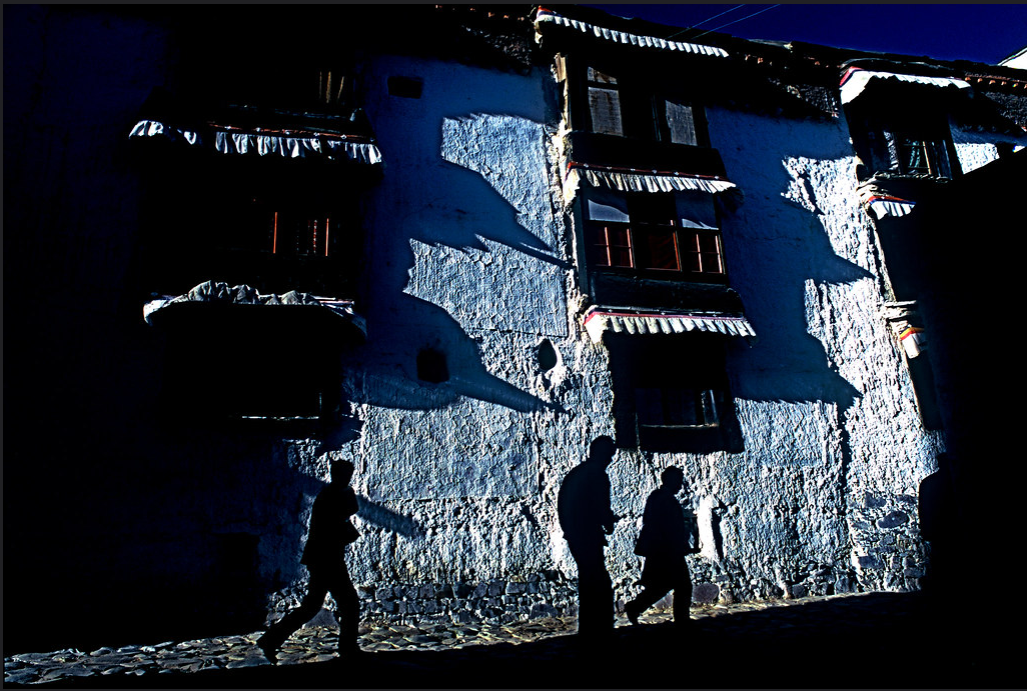
The lime covered walls of a monastery near Xigatse glisten in the stark winter light. China. © Shahidul Alam / Drik / Majority World
“The lime covered walls of a monastery near Xigatse glisten in the stark winter light.” This one is my all-time favorite. The characteristic light of the Himalayas; the sky peeping through a corner, the monastery hiding mysteries from ancient times and the human figures like ghosts escaping to hide before darkness settles. It is like a painting from the post-impressionist era.
Yet, a long-standing discord between Tibet and China, rising from disputed historical claims and the 1950 Chinese occupation of Tibet, has claimed this region for many years. China declares historical sovereignty over Tibet as part of its territory, while Tibetans assert their historical status as an independent nation. This ongoing dispute is characterized by China's assertion of control and administration over Tibet and the Tibetan government-in-exile's struggle for self-determination.
Yet, a long-standing discord between Tibet and China, rising from disputed historical claims and the 1950 Chinese occupation of Tibet, has claimed this region for many years. China declares historical sovereignty over Tibet as part of its territory, while Tibetans assert their historical status as an independent nation. This ongoing dispute is characterized by China's assertion of control and administration over Tibet and the Tibetan government-in-exile's struggle for self-determination.
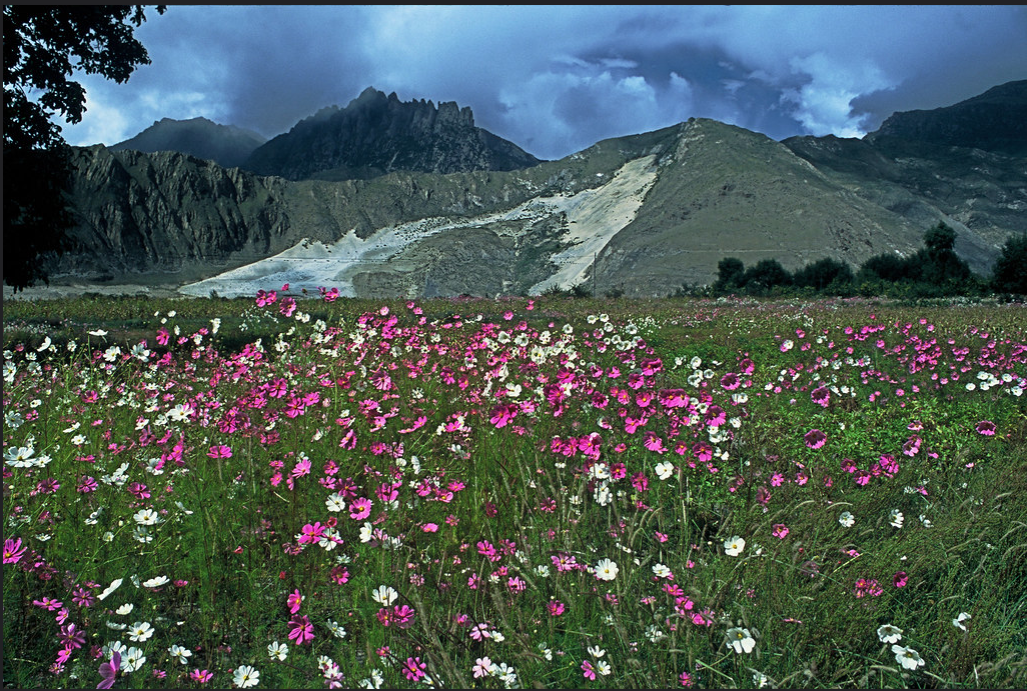
The Zhetang province is close to the Indian border, and forbidden to foreigners. The wild cosmos growing along the banks of the river, were inside a military base. China. © Shahidul Alam / Drik / Majority World
The wild cosmos growing along the banks of the river, were inside a military base, The Zhetang province. This image is my most beloved one, as it reflects such a gentle sense of peace and comfort. Nature is free here. The river is changing its rough character and becoming large and gentle.
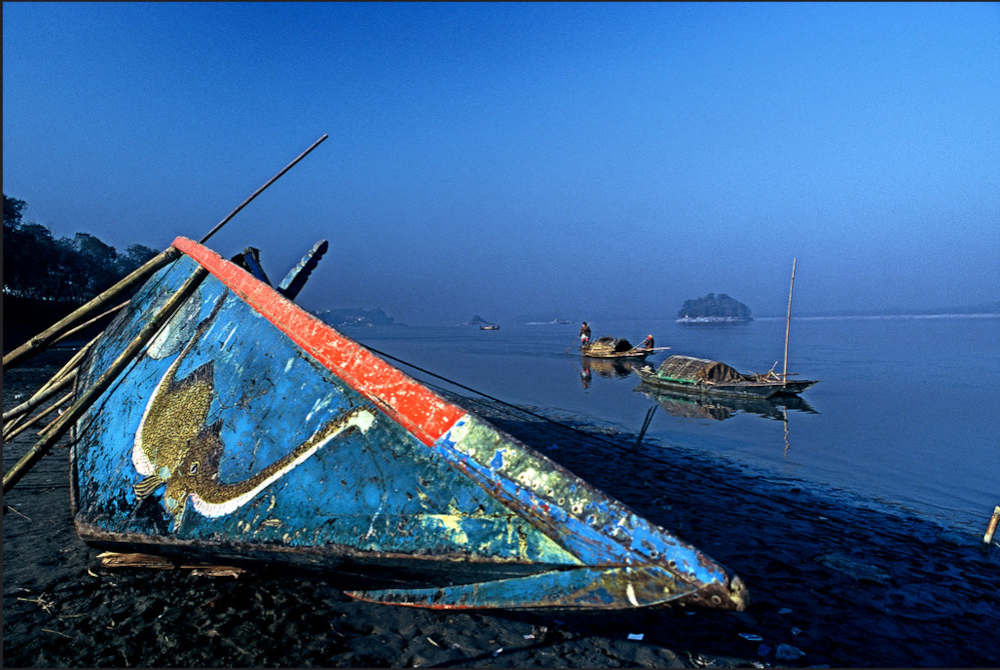 As the river Brahmaputra enters India from China, there is a change of race, language and religion. Buddhism, practiced in Tibet, gives way to Hinduism in India. © Shahidul
Alam / Drik / Majority World
As the river Brahmaputra enters India from China, there is a change of race, language and religion. Buddhism, practiced in Tibet, gives way to Hinduism in India. © Shahidul
Alam / Drik / Majority World
The river has entered into a flat landscape as Brahmaputra enters India from China. It sees a change of race, language and religion. It is a totally different river yet still the same: the river is now the source of livelihood.

Across the border in Pasighat in Arunachal Pradesh, a freshly made Kali (Mahakali) waits by the river around Diwali, the Hindu festival of lights. India. © Shahidul Alam / Drik / Majority World
Since I first saw this image, it has never left me. A goddess stands alone in the warm light, the paint drying off of her: Mahakali, the Hindu goddess of time and death. Shahidul met her across the border in Pasighat in Arunachal Pradesh, India.
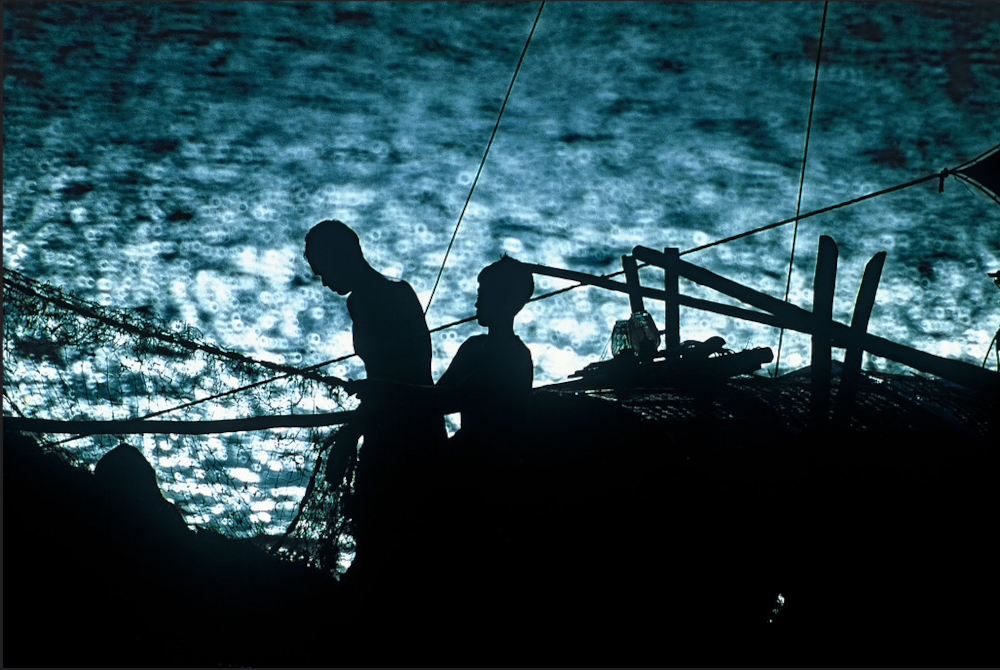
In Mawa ghat, fishing boats, which now often use motors rather than sails, leave in the afternoon, to fish all night. My 1000 mm Nikkor lens gave the shallow depth of field and created the doughnuts in the water. Bangladesh.© Shahidul Alam / Drik / Majority World
Now if this is not beautiful, then what is? This is a very artistic image of fishermen. Mawa Ghat is a busy zone and this image is a rare capture of people whose livelihood comes from the river, and whose lives have been touched by the river in a surreal way. The picture is taken at Mawa Ghat, Bangladesh.
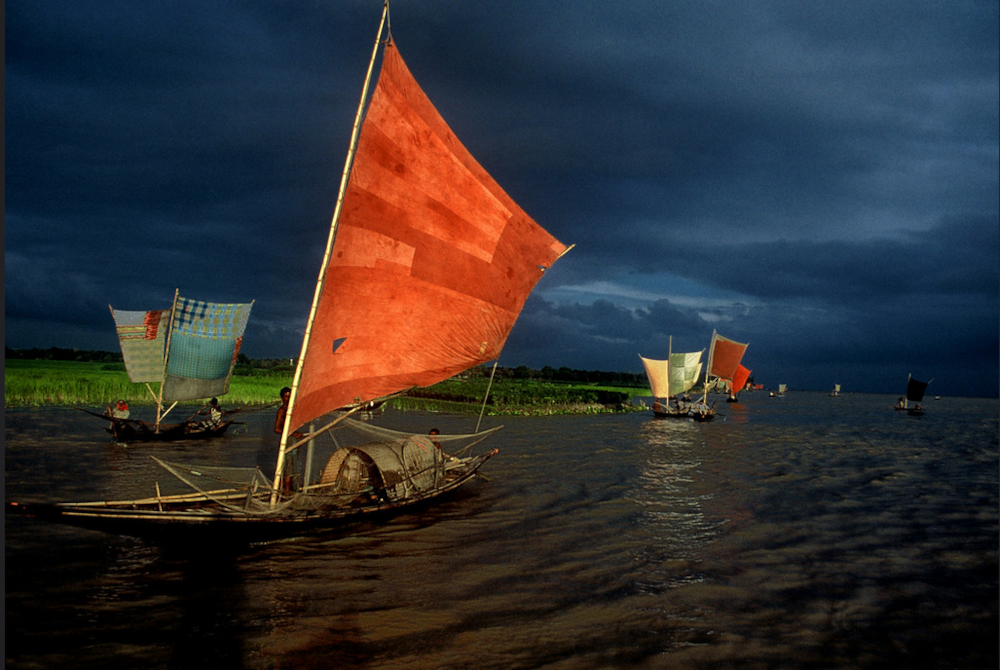
Ilish fishing 2001. Bangladesh. © Shahidul Alam / Drik / Majority World
Ilish fishing is perhaps the face of the Brahmaputra Diary. This one is a classic: impeccable in its composition. In his words Shahidul tells its story. “Sailboats are rapidly disappearing in Bangladesh, but small fishing boats still use them particularly during the monsoons. This photo was taken in Daulatdia, in the river Padma. The Ilish fish is a delicacy in Bangladesh, and the connoisseur will swear that the best Ilish is from the river Padma. It was overcast when I arrived and the light was flat, so I stayed with the fishermen. On day three there was an opening in the sky and a shaft of sunlight fell on the boats nearby. The dark clouds at the back were a perfect backdrop. The red sail was a bonus. The magical light only stayed for a few minutes, but that was enough. I had my picture.” Picture taken at Daulatdia in 2001. Bangladesh.
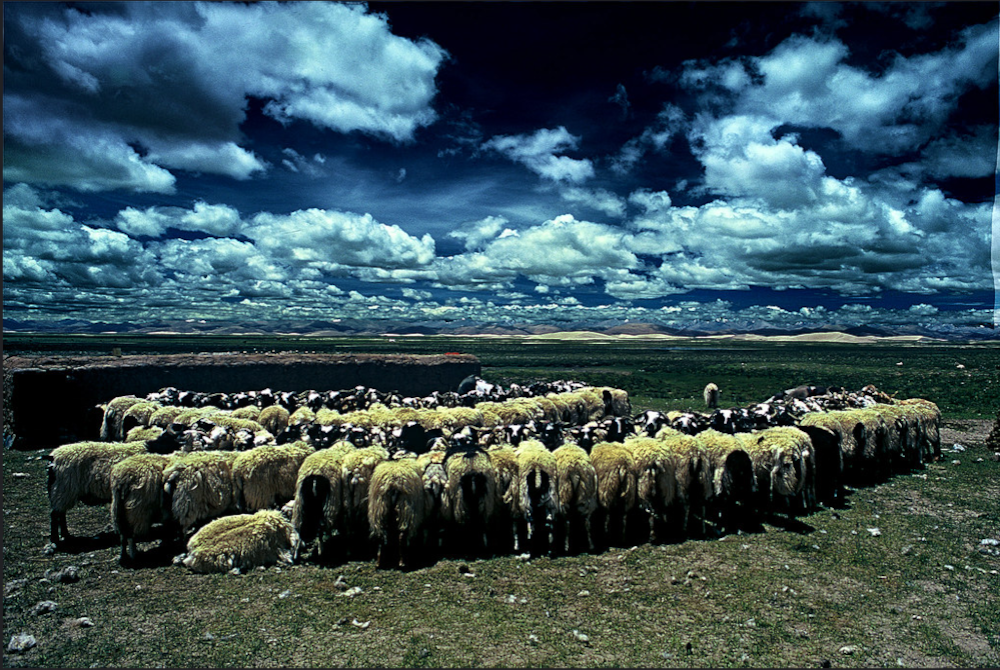
Most Tibetans outside of the major cities survive on livestock. Sheep is particularly important as it provides meat, milk and wool. In many parts of Tibet, sheep, yak, and wild horses are the only animals to be seen. With their horns entwined, Tibetan sheep obediently wait in queue to be milked. Chaina. © Shahidul Alam / Drik / Majority World
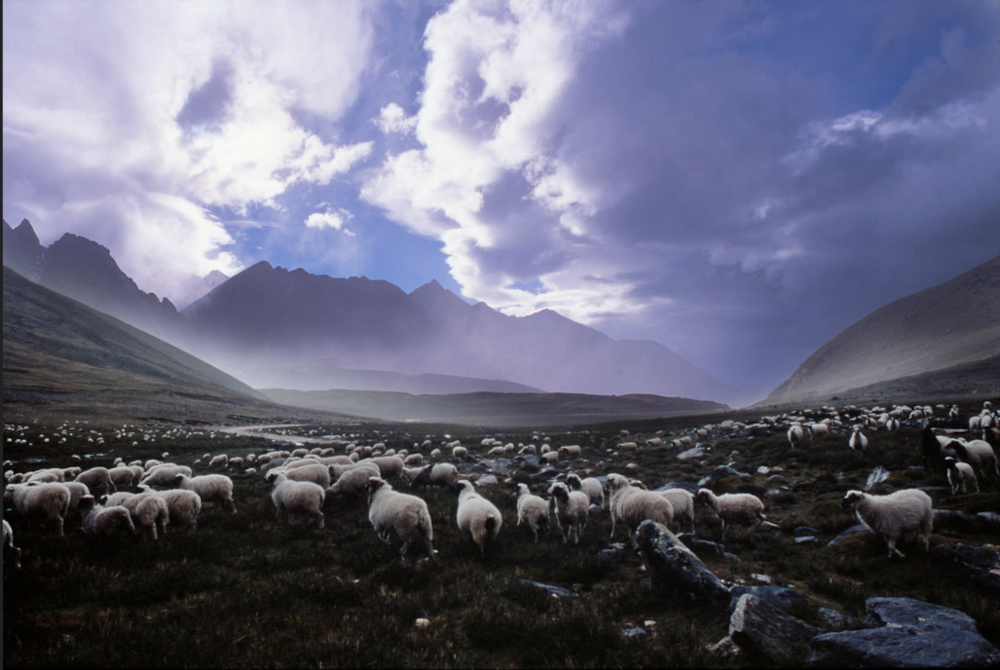
Sheep at sunset 1999. Sheep in Brahmaputra Valley. Close to the Asram of the great Bangla scholar Atish Dipankar. India. © Shahidul Alam / Drik / Majority World

Cows in Nijhum Dweep 2009. Bangladesh. © Shahidul Alam / Drik / Majority World
These three pictures are very similar yet hundreds of miles apart, connected by a river that gives meaning to them. Tibetan sheep obediently wait in queue to be milked at Tibet; a herd of sheep grazing in Brahmaputra Valley, India; and cows at Nijhum Dweep (Island of Silence), which is one of the most remote islands of Bangladesh and is situated in the Bay of Bengal.
The third picture marked the end of Shahidul’s journey along the Brahmaputra River from its source in Tibet to the Bay of Bengal where it meets the sea.
But the journey never ends. It has been 24 years, and many things are changing. China has begun constructing a large hydropower dam on the Brahmaputra River. The project is located in southeastern Tibet, near the border with India, which has raised concerns in downstream countries like India and Bangladesh due to the potential impacts on water flow and availability. Apart from this, climate change is taking a large toll on the Brahmaputra River. The looming fear of a catastrophic earthquake along a fault line can change the Brahmaputra River's course.
Yet the Brahmaputra Dairy will always be remembered as the best told story of a river which never stops flowing. I do not think anyone could have done it better than Shahidul. The images have a mystical rhyme about them; they stay with one as they ripple in the page’s memory, creating nostalgia in the folds of time.
The third picture marked the end of Shahidul’s journey along the Brahmaputra River from its source in Tibet to the Bay of Bengal where it meets the sea.
But the journey never ends. It has been 24 years, and many things are changing. China has begun constructing a large hydropower dam on the Brahmaputra River. The project is located in southeastern Tibet, near the border with India, which has raised concerns in downstream countries like India and Bangladesh due to the potential impacts on water flow and availability. Apart from this, climate change is taking a large toll on the Brahmaputra River. The looming fear of a catastrophic earthquake along a fault line can change the Brahmaputra River's course.
Yet the Brahmaputra Dairy will always be remembered as the best told story of a river which never stops flowing. I do not think anyone could have done it better than Shahidul. The images have a mystical rhyme about them; they stay with one as they ripple in the page’s memory, creating nostalgia in the folds of time.
Copyright of the photographs belongs to Shahidul Alam/Drik/Majority World. Any part of this article cannot be used without the written permission of the author.
